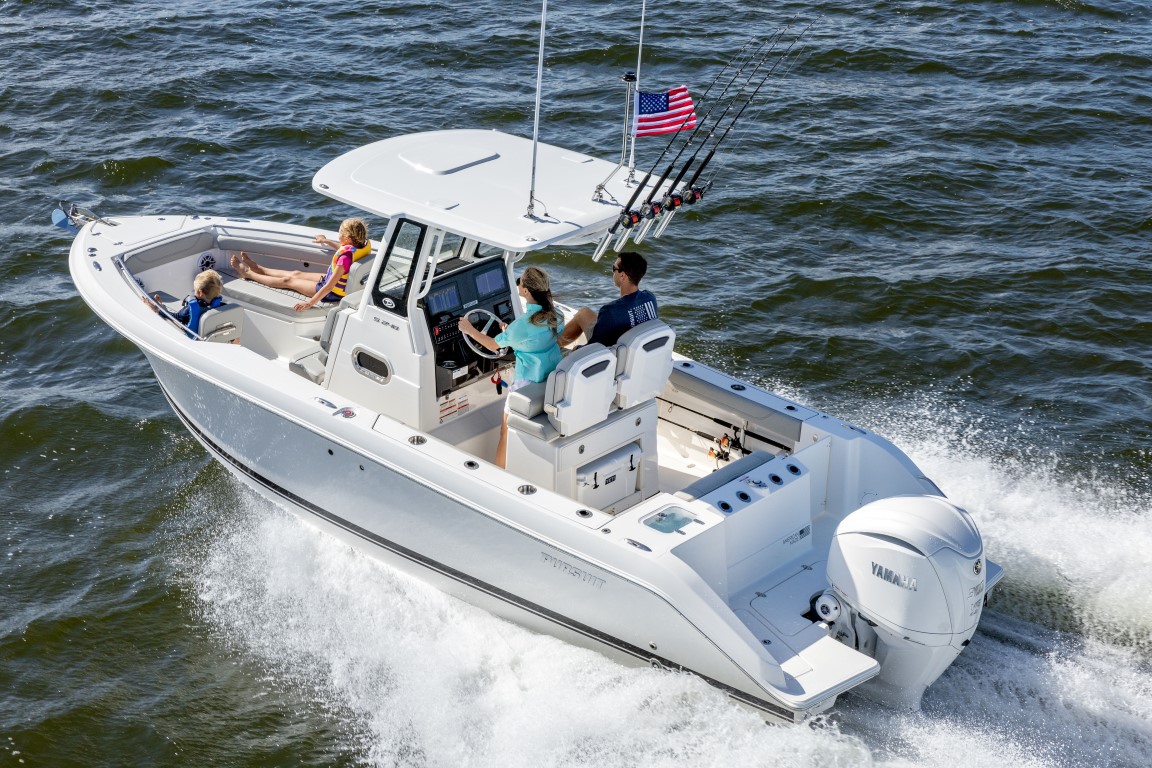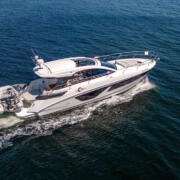Dual Console Vs. Center Console Boats
How to Choose Between a Center Console Boat and Dual Console Boat
Whether to choose a center console layout or dual console layout is a common decision when purchasing a new boat. The console design you’re going to be happiest with is ultimately going to be the one that suits what you want to get out of your boat.
Maybe you’re an avid fisherperson who is willing to trade a middle aisle and more seating for a larger helm with more space for custom electronics. Maybe you need a boat with seating and lounging zones to really entertain with class. There’s a lot to consider when it comes to choosing which type of powerboat and which type of console will be best for the type of adventures you want to have.
If you’re unsure about which length of boat to go for, read this article: What Length Boat is Right for Me?
What Is a Center Console Boat?
A center console has a single console that contains the helm, the Captain’s chair and usually one or more passenger seats. The amount of seating inside the center console will depend on the model and size of boat you buy.
Generally, a center console boat is designed for the more serious anglers who need to be able to move around the perimeter of the boat in a hurry. There’s no center aisle, so you can keep hold of the whopping halibut. You also get more raised deck space and work area with a center console boat, which many anglers prefer.
A smaller center console boat under 20 feet long will usually have up to two seats for the skipper/captain/whatever term you prefer to go by, while a larger boat 20 feet and longer might be built with a whole bench seat and entertainment area, complete with grill, sink, storage and more.
A center console is a bit like that pickup truck that you’d use to go hunting but wouldn’t necessarily take into the city. Just like that Supercab or Crew Cab with heated seats, moon roof, and LED screen. Today’s center console models have also evolved to include a whole host of luxury features as well. They’re no longer just bare-bones utilitarian models meant for angling and not much else, but that’s what single consoles were designed for and what they excel at.
What Is a Dual Console Boat?
A dual console boat has two consoles. One houses the helm and the other is for passengers who want to get out of the elements without going into the cabin. This gives the driver his or her own space to do their thing in the cockpit, while passengers have their own separate area to hang out.
The dual consoles create a walking path. This lets boaters easily access the bow and stern seating areas without needing to go all the way around the boat. This layout also means more options for dry storage. With more room for storage of food, supplies and other gear, it’s easier to enjoy longer trips.
With more seating and more storage, as well as two covered areas for passenger and driver, a dual console is ideal for family fun on the water.
Going with the vehicle analogy once again, a dual console is like the luxury minivan or SUV of the boat world – they’re loaded with features! You’ve got your multiple rows of seating, screens for the kiddies, tons of integrated storage, keyless access, and the cool sliding door that opens with a tap of your foot. Here, comfort is the highest priority, even though you might load it up with camping gear or drive it to your favourite hiking spot.
What Are the Pros of a Center Console Boat?
- Usually, a larger helm panel with more room for additional electronics and devices
- More deck space for baiting tackle and working with your catch
- Fewer obstructions along the rails make it more convenient for anglers
- Ideal for watersports
- Driver can have more privacy at the wheel
What Are the Pros of a Dual Console Boat?
- Typically larger than center console
- More entertainment and lounging spaces, like forward seating and convertible transom seating
- More dry storage space
- Best for leisure and group boating
- Offers greater weather and spray protection with a wraparound windshield
- Hardtop can cover the width of the boat to provide shade
- Passengers can remain on deck and away from the elements in second console
What Are the Cons of a Center Console Boat?
- Less weather protection
- There’s more deck space but less storage
- Tend to be smaller than dual console models
- Helm is usually smaller on a center console model
- Canopied console may not do as well in inclement weather
What Are the Cons of a Dual Console Boat?
- Deck space is usually sacrificed for extra seating
- Can move from bow to stern using the walkway, but can’t move around the perimeter
- Less room to stow rods and gear under the gunwales
- Less convenient for fishing
When Choosing Between Center or Dual Console, Think Pursuit Boats
After reading this, you probably have a good idea of whether a center or a dual console boat will fit your lifestyle the best. You can also read our blog post on choosing the right yacht for your needs.
The next step is to see the difference for yourself by viewing our range of watercraft in person! Seeing and touring the boats you’re most interested in will help you narrow your choices down.
At Van Isle Marina, we are the proud and exclusive dealer of Pursuit Boats right here on BC’s West Coast. We offer a spectacular collection of dual and single console vessels, designed to match your fishing, entertaining and cruising goals to a T. From the 26’ long C260 center console to the 37’ 11” D365 dual console model, there’s something to suit all needs. Made in the USA with the highest quality and dependability. One of these feature-packed Pursuits will be exactly right for you and whoever you love to spend time with on the water.
Ready to take the plunge? Contact our ultra-experienced yacht broker at Van Isle Marina. Located in beautiful Sidney, BC, we offer a wide range of luxurious new and used yachts and boats in addition to the complete line of Pursuit models. Call or email today to find the perfect fit for your boating needs.


